

2018 Chevrolet Corvette Stingray
The Corvette Stingray is the seventh generation (C7) version of Chevrolet's iconic sports car. Also offered as a convertible, it continues to offer the ingredients that have made Corvettes successful and beloved for decades - namely, prodigious V8 power and superb value - while addressing the shortcomings of its predecessors with a newly upscale interior and an increased level of overall refinement. Notably, it also packs more high-tech gadgetry than any previous 'Vette.
Recent Changes
The Stingray has received a handful of small updates for the latest model year, along with some shuffling of its package content and available options. A new limited-run "Carbon 65” Edition incorporates carbon fiber interior and exterior trim elements.
Overview
Outside, the new model features the same long hood, short rear deck proportions that have characterized Corvettes for decades, but the overall look is crisper and more angular than before. Notable touches include a tapered greenhouse, new rear-quarter windows and closely grouped, center-mounted quad exhaust pipes.
In a break with Corvette styling tradition, the usual rounded taillights have been replaced by new rhomboid units, which are grouped with functional vents. On models equipped with the Z51 performance package, they expel waste heat from transmission and rear differential coolers that are fed air by intakes mounted on the rear quarter panels.
In fact, all of the Corvette Stingray's various scoops and inlets are fully functional. Air released from the hood vent reduces front-end lift for improved steering response at high speeds, while the fender vents relieve underhood air pressure to reduce aerodynamic drag.
The Small Block Lives On
Like every Corvette since 1955, the Stingray is powered by a small block V8 - in this case, an all-new design known as the LT1. It churns out 455 horsepower at 6000 rpm and 460 lb-ft of torque at 4000 rpm, improvements of 25 ponies and 36 lb-ft over the old model's LS3. An optional dual-mode performance exhaust ups output slightly to 460 ponies and 465 lb-ft twist.
When given the cane, the Corvette Stingray can sprint from zero-to-60 mph in a supercar-like 3.8 seconds, and with over 400 lb-ft of twist on tap between 2,000 and 4,000 rpm, the LT1 also provides plenty of mid-range output.
While the tried-and-true pushrod configuration remains, the LT1 boasts direct-injection, variable valve timing and a fairly high 11.5:1 compression ratio. A dry sump oil system is optional extra in place of a standard wet sump unit.
The LT1 also integrates a cylinder deactivation system that saves fuel by effectively turning the 6.2-liter V8 into a 3.1-liter V4. When equipped with a manual transmission, the Corvette Stingray is rated at an impressive 17 mpg in the city and 29 mpg on the highway. Of note, those figures represent averages of the fuel economy in "Tour" drive mode, which delivers 28 mpg highway, and "Eco" drive mode, which returns 30 mpg highway (check below for a complete description of all drive modes).
Like the latest Porsche 911, the 'Vette's manual gearbox is a seven-speed unit. It features an "Active Rev Matching" system that provides rev-matched upshifts and downshifts. The function can be switched on or off via steering wheel-mounted paddles shifters - an unusual touch for a manual-equipped vehicle.
For those who prefer to rest their left foot, there's also a new eight-speed automatic transmission with paddle shifters. Fuel economy figures for the auto have not yet been released.
New Technology
New to the Corvette is the Driver Mode Selector, which lets drivers optimize the sports car for any given driving situation. It offers five different modes: Tour mode is the default setting for day to day driving; Weather mode is intended to provide additional confidence in rain or snow; Eco mode helps achieve maximum fuel efficiency; Sport mode is for spirited road driving and Track mode is, as one would expect, for track use.
The Drive Mode Selector modifies 12 different vehicle settings, including steering assist effort, throttle responsiveness, launch control calibrations, stability control settings, traction control parameters, exhaust noise levels, active fuel management setup, Performance Traction Management configurations, automatic transmission shift points, electronic limited-slip engagement and Magnetic Ride Control damper settings (the last two are Z51-exclusive features). Additionally, the gauge cluster changes to display information pertinent to the selected drive mode.
As before, a Z51 performance package will be available to make the Corvette even more track-friendly. It includes dry-sump lubrication, a stiffened suspension, closer manual-transmission gear ratios, an electronically-controlled limited-slip differential and additional cooling for the gearbox, differential and brakes. Also part of the package are upsized brakes and 19-by-8.5-inch front and 20-by-10-inch rear wheels and tires, compared with 18-by-8.5- and 19-by-10-inch as standard.
Available as an option on Z51-equipped models is the third-generation of GM's Magnetic Ride Control magneto-rheological dampers, which promise an excellent balance between ride comfort and handling precision. They incorporate a new twin-wire/dual-coil damper system that reacts 40 percent faster for improved ride comfort and body control.
Lightweight Components
For the first time, the base Corvette rides on an aluminum frame - a feature previously reserved for high-performance Z06 and Z51 models. The new setup is 99 pounds lighter and 57 percent stiffer than the C6's steel unit. To save additional weight, the hood and removable roof panel are constructed from carbon fiber, and the underbody trays are said to be lighter than before.
Despite those measures, the Corvette Stingray higher content level means it weighs in at about 3,300 lbs. - roughly 90 lbs. more than the C6. On the plus side, the extra mass is evenly distributed, as the sports car boasts a perfect 50/50 weight distribution.
The Inside Story
The two most highly criticized elements of the outgoing model's cabin - cheap materials and seats unbefitting of a performance car - have been addressed with Corvette Stingray. Soft-touch materials abound, and premium trimmings such as Nappa leather, micro-suede, aluminum and carbon fiber can be spec'd as options.
Two seating choices are on offer: comfort-oriented "GT" seats and "Competition Sport" thrones that promise the lateral support for which track-going Corvette enthusiasts have long clamored.
Eight-inch configurable screens are mounted at the center of the instrument cluster and at the top of the center stack, which is canted towards the driver and fitted with Corvette-specific HVAC controls. The later display is a touchscreen unit that controls Chevrolet's MyLink infotainment system, which integrates entertainment and navigation (when equipped) functions and additionally offers access to smartphone-based apps like Pandora radio and Stitcher radio. Buyers can order OnStar with 4G LTE and a built-in WiFi hotspot.
Dashboard knobs and steering wheel buttons give users alternate ways to control MyLink, and there's also a voice recognition system for hands-free calls, destination entering, song selection and more. Its "natural language" functioning can recognize a staggering number of phrases - effectively eliminating the need for the clunky and cumbersome memorized commands.
Performance Data Recorder
Buyers can order the Corvette with an optional Performance Data Recorder that captures not only a driver's perspective of the road ahead, but also a host of telemetry data for review at a later date.
Mounted into the windshield header trim near the rearview mirror, the system's 720p HD camera records everything the driver sees directly in front. Audio is picked up via a dedicated microphone inside the Corvette's camera, allowing drivers to narrate their own trip if they want.
Moreover, the system records data on an SD card that lets drivers replay their experiences either on the vehicle's instrument cluster (when parked) or on a computer or TV screen at a later date.
Four modes include three data overlay screens, which look something like a video game display:
Track mode - includes speed, RPM, g-force, lap times and even a location-based map discerned from the car's GPS and Bing-enabled satellite maps.
Sport mode - a more limited display with speed and g-force.
Performance mode - designed to show performance metrics like 0-60 mph runs, 1/4 mile sprints and 0-100 mph runs.
Touring mode - A simple video and audio-only replay.
Using Track mode, drivers can view corner traces, cornering force and vehicle speed to analyze their driving habits
Standard and Optional Features
The Stingray is offered with 1LT, 2LT and 3LT trim levels, all of which can be spec'd with a "Z51” Performance Package.
The 1LT comes standard with dual-zone automatic climate control, leather upholstery, power-adjustable seats, a nine-speaker Bose AM/FM/SiriusXM stereo with USB and AUX inputs and an SD card slot, MyLink infotainment with eight-inch touchscreen, Bluetooth connectivity and audio streaming, a rearview camera, Xenon headlights, LED running lights, a proximity key, push-button start, cruise control and silver-painted aluminum wheels measuring 18 inches in front and 19 inches in back.
The 2LT adds heated and ventilated seats, driver's seat memory settings an upgraded 10-speaker Bose sound system with bass box and HD radio, a head-up display and a cargo shade.
The 3LT brings upgraded leather upholstery and a navigation system.
Options include Competition Sport bucket seats, a dual-mode exhaust system and a Sueded Microfiber-Wrapped Upper Interior Trim package that swathes much of the cabin in sueded microfiber.
The Z51 performance package nets dry-sump lubrication, a stiffened suspension, closer manual-transmission gear ratios, a performance exhaust, an electronically-controlled limited-slip differential and additional cooling for the gearbox, differential and brakes. Also part of the package are upsized brakes and 19-by-8.5-inch front and 20-by-10-inch rear wheels and tires, compared with 18-by-8.5- and 19-by-10-inch as standard. It can be optioned with Magnetic Ride Control.
Buyers who want aesthetic upgrades without any mechanical modifications can opt for the ZF1 package that adds Z51 wheels and a rear spoiler.
Aimed at the track crowd, the Corvette Stingray Pacific Design Package can be added to any 2LT or 3LT coupe fitted with the Z51 performance package.
The Pacific trim adds satin black racing stripes, satin black wheels, carbon fiber accents both inside and out, red brake calipers and competition sport seats. The Pacific is limited to Torch Red, Black, Arctic White, Blade Silver and Shark Gray exterior colors.
Occupant Safety
All Corvette Stingray models come equipped with dual front and side airbags in addition to traction and stability control systems.
Key Competitors
As America's sports car, the Corvette Stingray competes against some of the world's finest performance machines: Porsche's Cayman and 911 models, the Nissan GT-R and the Dodge Viper, to name just a few.







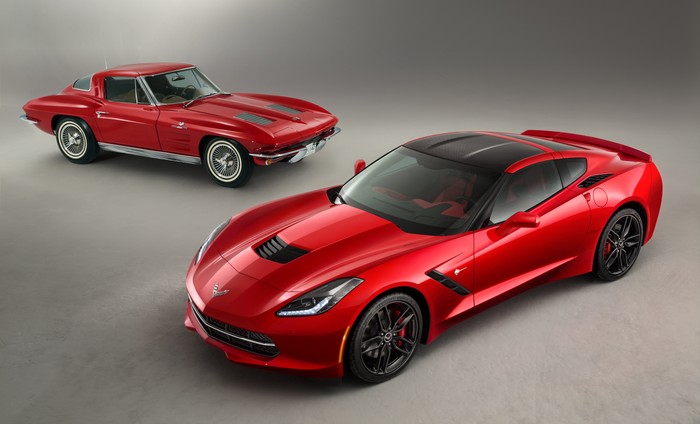





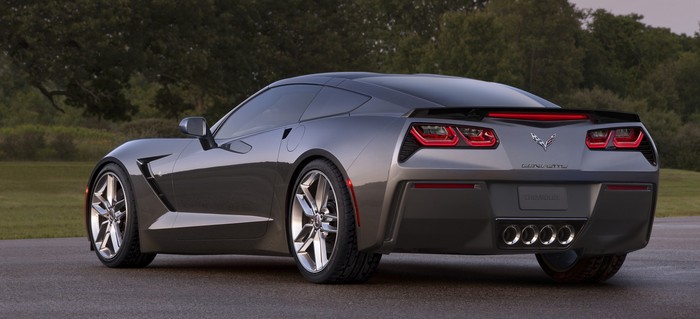









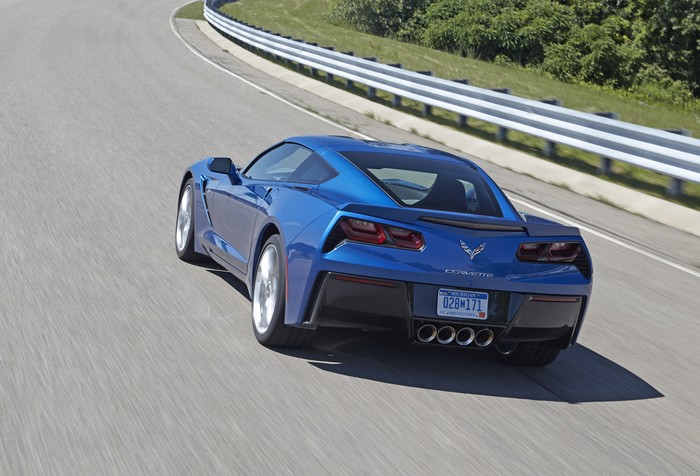



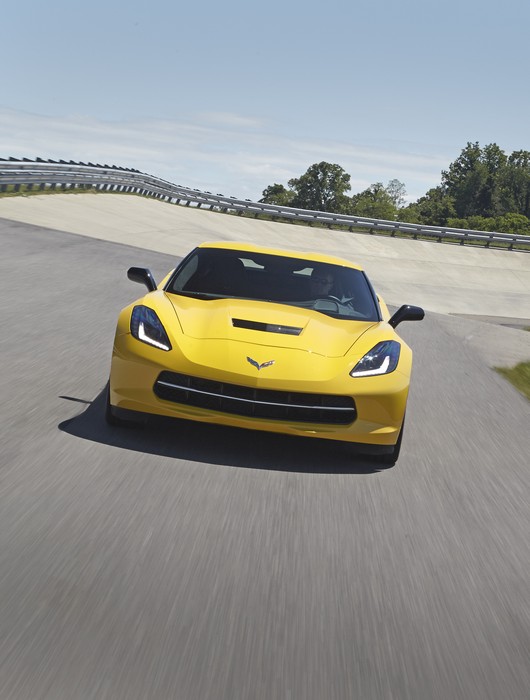

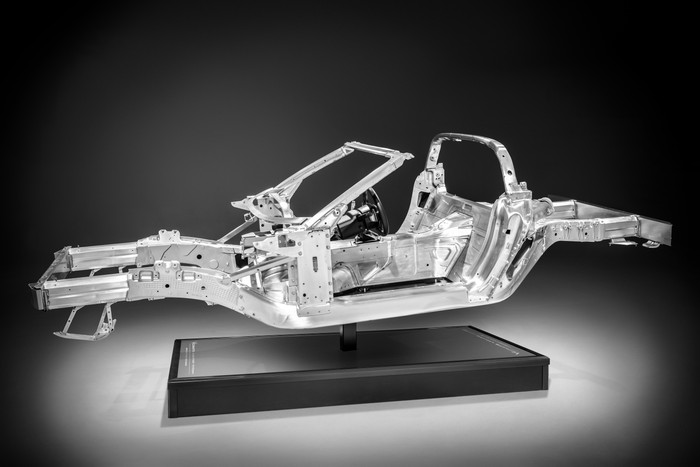







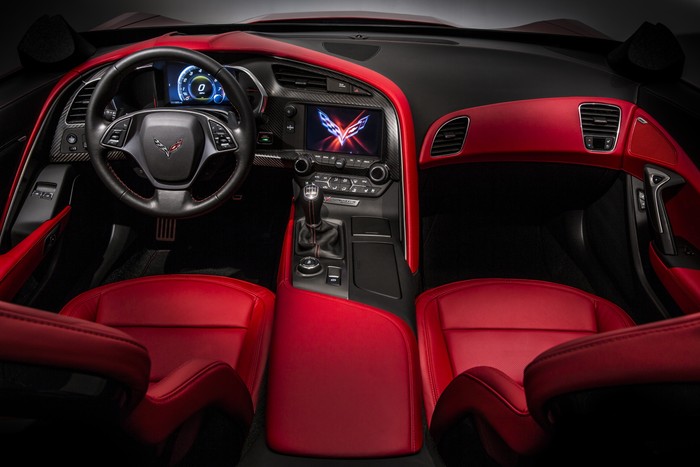













- Propulsion: Gas 6.2L V8
- Power: 455hp
@
6000rpm - Torque: 460ft⋅lb
@
4600rpm - Mileage: TBD MPG ( 16 city, 25 hwy)
- Transmission: 7-speed Manual
- Seating: 2 seats
in
1 row - Passenger Volume: 52.0cu ft
- Length: 176.9in
- Wheelbase: 106.7in
- Height: 48.8in
- Weight: 3298lbs
- Cargo Volume: 15.0cu ft
- Front Leg Room: 43.0in
- Front Head Room: 37.9in
- Front Hip Room: 53.7in
- Drag Coefficient: TBD
- Drag Coefficient: TBD